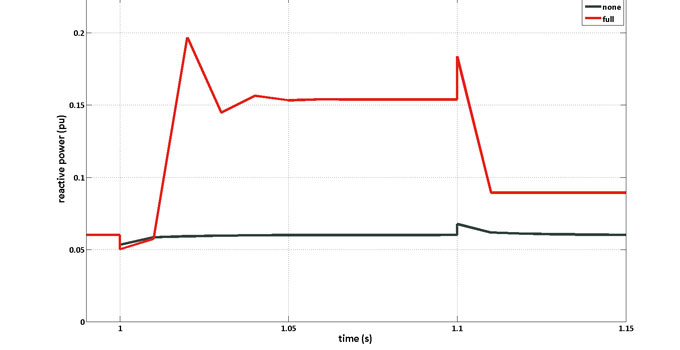THOUGHT LEADERSHIP
Binary states: the rise of the switching controller
The security of an electricity network is threatened by the rise of sophisticated controls on modern generating equipment. These controls lead to complex interactions with the electricity network and must be managed carefully to maintain reliable system security.
Transient stability power system modelling has almost always been the cosy domain of Laplace transforms and smooth, linear controls. The rise and abundance of power electronics in wind turbines and solar PV is changing this and adding a degree of discomfort.
These new controllers switch control modes based on internal and external variables, and as such introduce a new model phenomenon, the switch controller action. A switched controller can be particularly difficult to model accurately as it invariably switches based on an imperfect measurement of a process quantity, coupled with a time delay.
The switch will operate if the process quantity remains out of tolerance for the delay period. The imperfection in measurement can make it hard to accurately predict when or if a switching controller will operate. This can lead to a ‘Schrödinger’s cat’ scenario: the simulation continues past the switching point but we never know whether it should have switched or not, and if it had switched would the result be more or less valid? The simulation could just as correctly be in either state. Argh!

One school of thought is that more accurate and less assumptive modelling practice (such as using electro-magnetic transient simulations) might reduce this problem. However, it is highly unlikely that this form of modelling will deliver all the gains that its proponents expect. Rather, some conditions are likely to still give rise to the switching uncertainty, even with a much higher modelling cost.
Confronted with this uncertainty, how can we ensure that the modelling provides a useful insight into the limits of system operation? We’ll look at three scenarios: generator integration, system model validation, and system planning.
Generator integration
For generator integration, we typically define a set of boundary conditions and extreme event scenarios and determine whether the new generator is able to be connected within the system technical standards. This approach almost always ensures operation of the switching controllers that protect a generator from abnormal conditions, and there is no ambiguity of outcome. All good, job done? Well, no!
What if a slightly less severe system event leads to a condition in which the switching controller doesn’t activate but really should have? That’s a problem. This uncertainty requires us to define a much more complex set of scenarios to assure ourselves that a generator will comply with the technical standards.

System model validation
To validate system models, we generally measure responses from generating units and the system, and this tells us how the system and the generating units have behaved. So far, so good. Although, we don’t always know the severity of the instigating fault with any certainty, and this degree of freedom can open the dreaded window of switching controller uncertainty. Again, two possibilities exist in the model space: switching or not.
We know which is right, but is it fair to assume that the model inaccuracy suggested by comparison is entirely due to the generator with the switching controller? Um, well, probably not, but sometimes, yes. This is perhaps more difficult to resolve because it’s hard to unpick the sum of small inaccuracies in the system model from the clearly aberrant behaviour of the switching controller since the aberrant behaviour may be due to those summed inaccuracies.
System planning
The number of scenarios explored in system planning studies leads us to try to ignore the contributions of single generating units, or at least to assume accuracy in those contributions. Limits to system dispatch are established based on breakpoints such as transient stability and damping ratios. But how do we know we’re studying the correct, most onerous events? Severe events will always lead to switching controllers operating. Less severe events lead to hit-and-miss operation and potentially less stable system operation at potentially lower flows, so they must become part of our planning simulation considerations.
The rise of the switching controller and the uncertainty that it brings is a worrying development , with no easy work-around. Being aware of the conundrum should lead to accounting for it in some way. When the problem first arises during connection studies, the results at this stage can inform validation tests to increase the certainty of the modelling of the switching controller. Understanding the sensitivity of the controller to voltage and frequency variations and imbalance should provide an appreciation of the need for more advanced modelling, or not.
Switching controller uncertainty demands due consideration from network simulators lest the security of the power system is compromised and we all suffer.
If you would like to find out more about how Entura can help you adapt successfully to the rapidly changing market for electricity generation and energy services, contact Donald Vaughan on +61 3 6245 4279.
About the author
Donald Vaughan is Entura’s Technical Director, Power. He has more than 25 years of experience providing advice on regulatory and technical requirements for generators, substations and transmission systems. Donald specialises in the performance of power systems. His experience with generating units, governors and excitation systems provides a helpful perspective on how the physical electrical network behaves and how it can support the transition to a high renewables environment.
MORE THOUGHT LEADERSHIP ARTICLES
13 January, 2016






